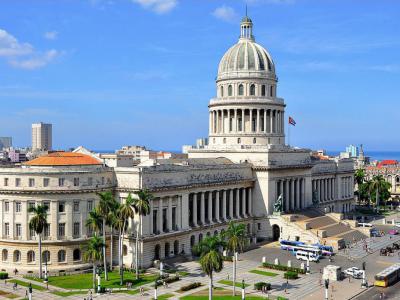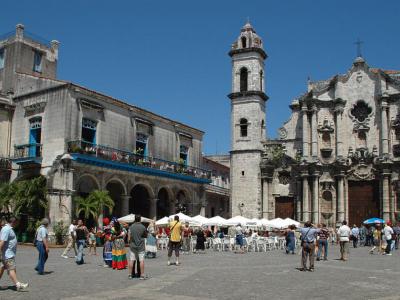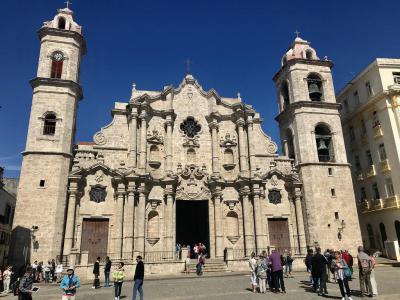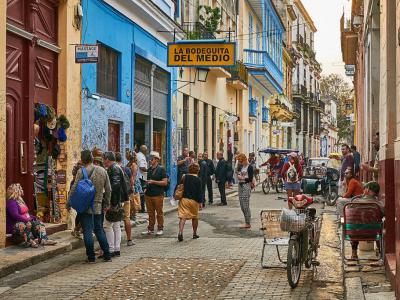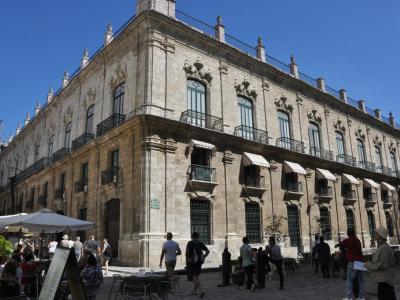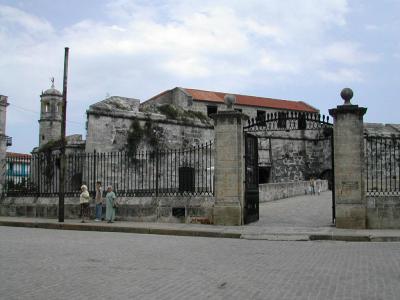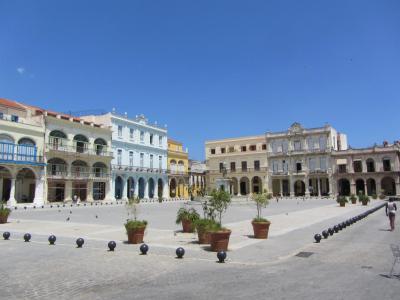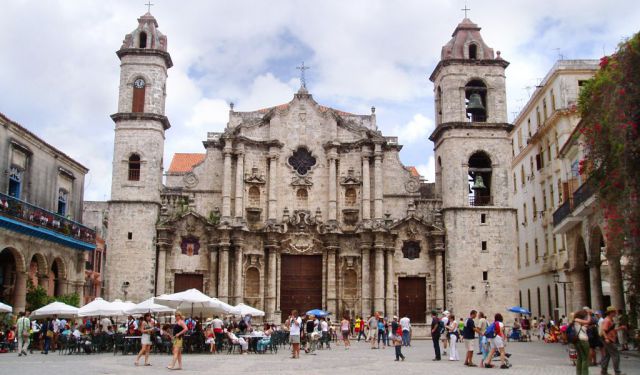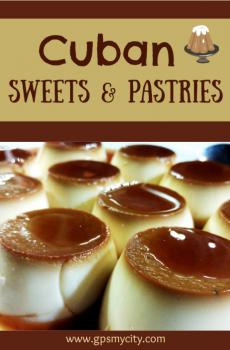Old Town Walking Tour (Self Guided), Havana
The Spanish founded Havana in 1519. After French pirate Jacques de Sores ransacked the city in 1555, the Castle of the Royal Force was built to protect the city.
Havana became a major stopping point between the newly discovered Americas and ancient Europe. In the 1600s, Havana was a major shipbuilding port.
Old Havana is listed as a UNESCO World Heritage Site. The historic city has five squares filled with gorgeous Baroque and neoclassical architecture. El Capitolio, or the National Capital Building, is the heart of Old Havana. Directions in Havana are given with distances measured from El Capitolio. People compare this stately building to the Pantheon and the U.S. Capitol.
Admire the 1777 Havana Cathedral with its asymmetrical bell towers. The Square of Arms is Havana's oldest square and connects all of Old Havana's oldest streets. The Castle of the Royal Force now holds a museum where you can see the original La Giraldilla weathervane figure.
The arches and stain glass windows in the many unique Old Square buildings are photo-worthy. You're invited to shop, drink cafecitos, and browse art galleries on the narrow cobblestone Bishop Street.
There's more than architecture to appreciate in Old Havana. Many visitors enjoy sipping mojitos at Bodeguita del Medio and studying the celebrity signatures on the walls. Check out Ernest Hemingway's room at Hotel Ambos Mundos, which remains as it was when the famous author lived there in the 1930s.
Havana is a beautiful city bursting with history and friendly locals. Join us on a self-guided walking tour to explore the most notable sights of Old Havana.
Havana became a major stopping point between the newly discovered Americas and ancient Europe. In the 1600s, Havana was a major shipbuilding port.
Old Havana is listed as a UNESCO World Heritage Site. The historic city has five squares filled with gorgeous Baroque and neoclassical architecture. El Capitolio, or the National Capital Building, is the heart of Old Havana. Directions in Havana are given with distances measured from El Capitolio. People compare this stately building to the Pantheon and the U.S. Capitol.
Admire the 1777 Havana Cathedral with its asymmetrical bell towers. The Square of Arms is Havana's oldest square and connects all of Old Havana's oldest streets. The Castle of the Royal Force now holds a museum where you can see the original La Giraldilla weathervane figure.
The arches and stain glass windows in the many unique Old Square buildings are photo-worthy. You're invited to shop, drink cafecitos, and browse art galleries on the narrow cobblestone Bishop Street.
There's more than architecture to appreciate in Old Havana. Many visitors enjoy sipping mojitos at Bodeguita del Medio and studying the celebrity signatures on the walls. Check out Ernest Hemingway's room at Hotel Ambos Mundos, which remains as it was when the famous author lived there in the 1930s.
Havana is a beautiful city bursting with history and friendly locals. Join us on a self-guided walking tour to explore the most notable sights of Old Havana.
How it works: Download the app "GPSmyCity: Walks in 1K+ Cities" from Apple App Store or Google Play Store to your mobile phone or tablet. The app turns your mobile device into a personal tour guide and its built-in GPS navigation functions guide you from one tour stop to next. The app works offline, so no data plan is needed when traveling abroad.
Old Town Walking Tour Map
Guide Name: Old Town Walking Tour
Guide Location: Cuba » Havana (See other walking tours in Havana)
Guide Type: Self-guided Walking Tour (Sightseeing)
# of Attractions: 11
Tour Duration: 2 Hour(s)
Travel Distance: 2.7 Km or 1.7 Miles
Author: alex1007
Sight(s) Featured in This Guide:
Guide Location: Cuba » Havana (See other walking tours in Havana)
Guide Type: Self-guided Walking Tour (Sightseeing)
# of Attractions: 11
Tour Duration: 2 Hour(s)
Travel Distance: 2.7 Km or 1.7 Miles
Author: alex1007
Sight(s) Featured in This Guide:
- El Capitolio (The Capitol Building)
- Gran Teatro de La Habana (Great Theatre of Havana)
- Calle Obispo (Bishop Street)
- Plaza de la Catedral (Cathedral Square)
- Havana Cathedral
- Bodeguita del Medio
- Palace of the Captains-Generals / Havana City Museum
- Plaza de Armas (Square of Arms)
- Castle of the Royal Force
- Plaza de San Francisco de Asís (Saint Francis of Assisi Square)
- Plaza Vieja (Old Square)
1) El Capitolio (The Capitol Building) (must see)
El Capitolio, or the National Capital Building, is one of the most visited and photographed buildings in Havana. It was completed in 1929 under the Gerardo Machado administration. El Capitolio is located in the exact center of Havana. The Congress convened here until the 1959 Cuban Revolution. After that, the building fell into disrepair. In 2013, the government began repairs to restore the building.
El Capitolio is very similar to the U.S. Capitol, but El Capitolio is one meter higher, longer, and wider. The cupola, or dome, was inspired by the French Pantheon. At 92 meters (302 feet) high, El Capitolio's dome was the third-highest dome in the world when it was built.
There are 56 steps up to the main entrance. The steps are flanked by two six and a half meter (21 foot) tall statues. After climbing the steps, visitors will be greeted by twelve 14-meter (46-foot) tall columns decorating the central portico. The entrance has three large bronze doors with detailed bas relief plates. Entering the main hall, visitors will find the Statue of the Republic. At 15 meters (49 feet) tall, this gold-plated statue is the third tallest indoor statue in the world.
The exact center of Havana is marked with a replica diamond. The original 25-carat diamond was stolen in 1946. After it was recovered, the original diamond did not return to public display.
The formal gardens surrounding El Capitolio were designed by Jean-Claude Nicolas Forestier, who designed the park next to the Eiffel Tour in Paris.
Why You Should Visit:
It's impossible to visit Havana without a visit to El Capitolio. The building dominates the landscape. As it is the center of Havana, locals give directions based on distances from El Capitolio. Visiting El Capitolio will orient you to the rest of the city. Admire the beautiful architecture and learn more about Cuba's history.
Tips:
Visit in the day to admire the details and take a tour of the interior in Spanish or English. Return at night to admire El Capitolio stunningly lit up.
El Capitolio is very similar to the U.S. Capitol, but El Capitolio is one meter higher, longer, and wider. The cupola, or dome, was inspired by the French Pantheon. At 92 meters (302 feet) high, El Capitolio's dome was the third-highest dome in the world when it was built.
There are 56 steps up to the main entrance. The steps are flanked by two six and a half meter (21 foot) tall statues. After climbing the steps, visitors will be greeted by twelve 14-meter (46-foot) tall columns decorating the central portico. The entrance has three large bronze doors with detailed bas relief plates. Entering the main hall, visitors will find the Statue of the Republic. At 15 meters (49 feet) tall, this gold-plated statue is the third tallest indoor statue in the world.
The exact center of Havana is marked with a replica diamond. The original 25-carat diamond was stolen in 1946. After it was recovered, the original diamond did not return to public display.
The formal gardens surrounding El Capitolio were designed by Jean-Claude Nicolas Forestier, who designed the park next to the Eiffel Tour in Paris.
Why You Should Visit:
It's impossible to visit Havana without a visit to El Capitolio. The building dominates the landscape. As it is the center of Havana, locals give directions based on distances from El Capitolio. Visiting El Capitolio will orient you to the rest of the city. Admire the beautiful architecture and learn more about Cuba's history.
Tips:
Visit in the day to admire the details and take a tour of the interior in Spanish or English. Return at night to admire El Capitolio stunningly lit up.
2) Gran Teatro de La Habana (Great Theatre of Havana) (must see)
The Great Theatre of Havana (Gran Teatro de La Habana) is a significant symbol of Cuba's cultural heritage and its historical connection with Spain, through the support of Galician immigrants who funded its construction. The theater functions not only as a performance venue but also as a comprehensive cultural complex, housing the Cuban National Ballet and hosting various artistic events.
Its origins can be traced back to the Tacón Theatre, a cultural hub in Havana since 1838, where renowned international artists like Enrico Caruso and Sarah Bernhardt performed. In the early 20th century, the Centro Gallego was built around the original Tacón Theatre to cater to the social and cultural needs of the Galician immigrant community. This integration resulted in a sophisticated complex featuring theaters, a concert hall, conference rooms, an art gallery, and rehearsal spaces.
Built in 1914 by Belgian architect Paul Belau and engineered by the American firm Purdy and Henderson, the theater replaced the older Tacón Theatre. Architecturally, the Great Theatre of Havana boasts an elaborate Baroque Revival style, with the original Tacón Theatre's exterior receiving new stone facing to match the grandeur of the Centro Gallego. Sculptures by artists Giuseppe Moretti and Geneva Mercer adorn the building, representing themes of charity, education, music, and theater, adding cultural depth to its visual appeal.
A notable feature is the bronze sculpture of Alicia Alonso, the legendary Cuban ballerina, created by sculptor José Villa Soberón and named "Giselle" after one of Alonso's famous ballets. This sculpture, located in the theater's lobby, pays homage to Alonso's contributions to dance and the National Ballet of Cuba.
The theater's main venue, the García Lorca Auditorium, seats 1,500 and remains a focal point for cultural activities, including performances by the Cuban National Ballet and the International Ballet Festival of Havana, held biennially since 1960, attracting talents from around the world.
Its origins can be traced back to the Tacón Theatre, a cultural hub in Havana since 1838, where renowned international artists like Enrico Caruso and Sarah Bernhardt performed. In the early 20th century, the Centro Gallego was built around the original Tacón Theatre to cater to the social and cultural needs of the Galician immigrant community. This integration resulted in a sophisticated complex featuring theaters, a concert hall, conference rooms, an art gallery, and rehearsal spaces.
Built in 1914 by Belgian architect Paul Belau and engineered by the American firm Purdy and Henderson, the theater replaced the older Tacón Theatre. Architecturally, the Great Theatre of Havana boasts an elaborate Baroque Revival style, with the original Tacón Theatre's exterior receiving new stone facing to match the grandeur of the Centro Gallego. Sculptures by artists Giuseppe Moretti and Geneva Mercer adorn the building, representing themes of charity, education, music, and theater, adding cultural depth to its visual appeal.
A notable feature is the bronze sculpture of Alicia Alonso, the legendary Cuban ballerina, created by sculptor José Villa Soberón and named "Giselle" after one of Alonso's famous ballets. This sculpture, located in the theater's lobby, pays homage to Alonso's contributions to dance and the National Ballet of Cuba.
The theater's main venue, the García Lorca Auditorium, seats 1,500 and remains a focal point for cultural activities, including performances by the Cuban National Ballet and the International Ballet Festival of Havana, held biennially since 1960, attracting talents from around the world.
3) Calle Obispo (Bishop Street) (must see)
Widely regarding as one of the busiest streets in Old Havana, Bishop's Street is part of the historic city center, filled to the brim with plethora of shops, art galleries, hotels, restaurants, live music bars and a regular crowd of people. The street is lined with four- and five-story buildings which block out most of the sunlight and altogether give the place a great deal of character.
It is called Bishop Street after two famous bishops lived here. Bishop Fray Jeronimo de Lara lived here in 1641 and another bishop Pedro Agustin Morell de Santa Cruz, used to traverse the street regularly from his nearby home.
One of the most notable sights here, from both aesthetic and architectonic standpoints, is the Ministry of Finances and Prices, formerly center of the banking triangle, back in the early 20th century colloquially referred to as the Havana Wall Street.
Among other attractions is the Florida Hotel and Ambos Mundos Hotel. Hotel Ambos Mundos sits on the corner of Calle Obispo and Mercaderes. This hotel is famous for hosting renowned author Ernest Hemingway. Hemingway lived in the hotel from 1932 to 1939 and began his novel For Whom the Bell Tolls while staying at Hotel Ambros Mundos. Today, Hemingway's room, Number 511, is set up as a small Hemingway museum. The room is decorated and laid out as it was when Hemingway lived there and is available for tours.
It is called Bishop Street after two famous bishops lived here. Bishop Fray Jeronimo de Lara lived here in 1641 and another bishop Pedro Agustin Morell de Santa Cruz, used to traverse the street regularly from his nearby home.
One of the most notable sights here, from both aesthetic and architectonic standpoints, is the Ministry of Finances and Prices, formerly center of the banking triangle, back in the early 20th century colloquially referred to as the Havana Wall Street.
Among other attractions is the Florida Hotel and Ambos Mundos Hotel. Hotel Ambos Mundos sits on the corner of Calle Obispo and Mercaderes. This hotel is famous for hosting renowned author Ernest Hemingway. Hemingway lived in the hotel from 1932 to 1939 and began his novel For Whom the Bell Tolls while staying at Hotel Ambros Mundos. Today, Hemingway's room, Number 511, is set up as a small Hemingway museum. The room is decorated and laid out as it was when Hemingway lived there and is available for tours.
4) Plaza de la Catedral (Cathedral Square) (must see)
Plaza de la Catedral is one of five main squares in old Havana. The Catedral de San Cristobal (Havana Cathedral) dominates the plaza. The construction of this cathedral was completed in 1777. The Catedral de San Cristobal held the remains of Christopher Columbus from 1796 to 1898.
The Catedral de San Cristobal was built in the Baroque style and features two asymmetrical bell towers. The Catedral was constructed from blocks of coral; you can see fossilized marine life in the blocks. Inside The Catedral, you will find many interesting sculptures and paintings, such as a 1632 sculpture of Saint Christopher, Patron Saint of Havana.
Admire the magnificent mansions built by Cuba's elite, which surround the square. These mansions have since become landmarks and museums.
Don't miss the Casa de Lombillo. The Casa de Lombillo housed the first Cuban post office and is now a museum. The Casa del Conde de Casa Bayona is now the Museo de Arte Colonial. The Casa de Los Condes de Peñalver which now functions as one of Cuba's premier art galleries.
Why You Should Visit:
Visiting the Plaza de la Catedral is like stepping back in time. The Catedral de San Cristobal and mansions built here are absolutely beautiful. This area of Old Havana has been designated as a UNESCO World Heritage Site, and it's easy to see why.
Plaza de la Catedral is also a social center for locals. You might see kids engaging in an impromptu soccer game, entertainers on stilts, or fortune-tellers ready to tell your fortune.
Tips:
To take in the square like a local, stop by El Patio Colonial for a meal. Sit inside, under the portico, or enjoy the sunshine on the plaza. This popular restaurant is located inside Casa de Los Marqueses de Aguas Claras, which was once owned by a descendent of Ponce de Leon.
The Catedral de San Cristobal was built in the Baroque style and features two asymmetrical bell towers. The Catedral was constructed from blocks of coral; you can see fossilized marine life in the blocks. Inside The Catedral, you will find many interesting sculptures and paintings, such as a 1632 sculpture of Saint Christopher, Patron Saint of Havana.
Admire the magnificent mansions built by Cuba's elite, which surround the square. These mansions have since become landmarks and museums.
Don't miss the Casa de Lombillo. The Casa de Lombillo housed the first Cuban post office and is now a museum. The Casa del Conde de Casa Bayona is now the Museo de Arte Colonial. The Casa de Los Condes de Peñalver which now functions as one of Cuba's premier art galleries.
Why You Should Visit:
Visiting the Plaza de la Catedral is like stepping back in time. The Catedral de San Cristobal and mansions built here are absolutely beautiful. This area of Old Havana has been designated as a UNESCO World Heritage Site, and it's easy to see why.
Plaza de la Catedral is also a social center for locals. You might see kids engaging in an impromptu soccer game, entertainers on stilts, or fortune-tellers ready to tell your fortune.
Tips:
To take in the square like a local, stop by El Patio Colonial for a meal. Sit inside, under the portico, or enjoy the sunshine on the plaza. This popular restaurant is located inside Casa de Los Marqueses de Aguas Claras, which was once owned by a descendent of Ponce de Leon.
5) Havana Cathedral (must see)
Constructed by the Jesuits (1748–77) on the site of an earlier church, Havana Cathedral is one of eleven Catholic cathedrals on the island. It is sometimes dubbed as Christopher Cathedral for being the place where Christopher Columbus’ remains were kept between 1796 and 1898 before they were returned to Spain after the Cuban War of Independence.
The Cathedral is said to be the only example of a baroque facade that was designed with asymmetrical features – one of the towers is wider than the other. This particular feature was conceived in order to allow the water that tended to accumulate on the plaza to freely flow through the streets during the colonial period when it was built.
Cuban writer Alejo Carpentier famously described the Cathedral as "music set in stone". In fact, its structure is notable for being built with stones which are very different from what are used to in Europe. The stones lend the cathedral a particular color and it is really beautiful. Nearby there are terraces, music, and people all around offering drinks, food, cigars, and many more – the essence of the city.
Tip:
Note that despite the official opening times, the Cathedral is often locked, though you can sometimes gain access just before mass. Admission is free, although there is a small charge if you wish to go up the bell tower. Cover-ups for those with short shorts or bare shoulders are available for free
The Cathedral is said to be the only example of a baroque facade that was designed with asymmetrical features – one of the towers is wider than the other. This particular feature was conceived in order to allow the water that tended to accumulate on the plaza to freely flow through the streets during the colonial period when it was built.
Cuban writer Alejo Carpentier famously described the Cathedral as "music set in stone". In fact, its structure is notable for being built with stones which are very different from what are used to in Europe. The stones lend the cathedral a particular color and it is really beautiful. Nearby there are terraces, music, and people all around offering drinks, food, cigars, and many more – the essence of the city.
Tip:
Note that despite the official opening times, the Cathedral is often locked, though you can sometimes gain access just before mass. Admission is free, although there is a small charge if you wish to go up the bell tower. Cover-ups for those with short shorts or bare shoulders are available for free
6) Bodeguita del Medio
Bodeguita del Medio is renowned not so much for its cuisine as it is for its famous clientele. Prominent guests have included Nat King Cole, Pablo Neruda, Gabriel García Márquez, Ernest Hemingway, Gabriela Mistral, Agustín Lara, Joan Manuel Serrat, Nicolás Guillén, Salvador Allende, and Julio Cortázar.
In the 1940s, Bodeguita del Medio began serving a new cocktail, the mojito. This fabulous cocktail attracted locals who wanted to sip a drink and chat with friends. In the 1950s, Bodeguita del Medio began serving food.
Celebrities have inscribed their signatures on the walls, and the decor includes black and white photos of famous guests. Live Cuban music adds to the cozy ambiance.
This used to be another of Hemingway’s favorite bars and he often came here to enjoy his mojitos. While a signature on the wall is signed by "Ernest Hemingway," the authenticity of the quote and signature has been contested. Regardless, this bar still has some of the best mojitos in Havana and it is a place to see and be seen.
Today, you can stop by for a traditional mojito and savory Cuban food, but be prepared to wait for a table at this popular spot.
In the 1940s, Bodeguita del Medio began serving a new cocktail, the mojito. This fabulous cocktail attracted locals who wanted to sip a drink and chat with friends. In the 1950s, Bodeguita del Medio began serving food.
Celebrities have inscribed their signatures on the walls, and the decor includes black and white photos of famous guests. Live Cuban music adds to the cozy ambiance.
This used to be another of Hemingway’s favorite bars and he often came here to enjoy his mojitos. While a signature on the wall is signed by "Ernest Hemingway," the authenticity of the quote and signature has been contested. Regardless, this bar still has some of the best mojitos in Havana and it is a place to see and be seen.
Today, you can stop by for a traditional mojito and savory Cuban food, but be prepared to wait for a table at this popular spot.
7) Palace of the Captains-Generals / Havana City Museum
The Museum of the City of Havana is housed in the old Palace of the Captains General (Palacio de los Capitanes Generales), a prominent Cuban Baroque-style mansion that occupies the entire western side of the Main Square (Plaza de Armas) in Havana. Constructed in the 1770s, this grand edifice served as the residence for the Spanish governors of Havana and later transitioned to the city's town hall in the post-colonial era. Its architectural significance and historical relevance have earned a place within the UNESCO World Heritage Site designation for "Old Havana and its Fortification System."
The Palace's design is quintessentially Cuban Baroque, characterized by thick walls, an arcade with arches supported by columns, and floors made of a distinctive paving material. The first story features a limestone façade, sourced locally and embedded with marine fossils, showcasing small balconies and stained-glass windows that align with the columns below. The courtyard, adorned with trees and peacocks, features a white marble statue of Christopher Columbus dating back to 1862.
Inside, the museum's ground floor and mezzanine display a collection of art and artifacts that narrate Havana's storied past. Among its treasures are the "La Giradilla" statue, the Cenotaph from the Parroquial Mayor Church, and relics from the Espada Cemetery, including Jean Baptiste Vermay's tomb.
The museum's exhibits extend to a range of subjects, reflecting on Cuba's historical narrative through antique furniture, photography, horse-drawn carriages, and military attire. Notably, it houses Cuba's inaugural flag and the boat used by Antonio Maceo in 1896. The Salón del Trono, or Throne Room, is another highlight, showcasing a throne that was prepared for an anticipated royal visit from the King of Spain that never transpired.
Tip:
Make sure that you buy a ticket that shows all the exhibits.
The Palace's design is quintessentially Cuban Baroque, characterized by thick walls, an arcade with arches supported by columns, and floors made of a distinctive paving material. The first story features a limestone façade, sourced locally and embedded with marine fossils, showcasing small balconies and stained-glass windows that align with the columns below. The courtyard, adorned with trees and peacocks, features a white marble statue of Christopher Columbus dating back to 1862.
Inside, the museum's ground floor and mezzanine display a collection of art and artifacts that narrate Havana's storied past. Among its treasures are the "La Giradilla" statue, the Cenotaph from the Parroquial Mayor Church, and relics from the Espada Cemetery, including Jean Baptiste Vermay's tomb.
The museum's exhibits extend to a range of subjects, reflecting on Cuba's historical narrative through antique furniture, photography, horse-drawn carriages, and military attire. Notably, it houses Cuba's inaugural flag and the boat used by Antonio Maceo in 1896. The Salón del Trono, or Throne Room, is another highlight, showcasing a throne that was prepared for an anticipated royal visit from the King of Spain that never transpired.
Tip:
Make sure that you buy a ticket that shows all the exhibits.
8) Plaza de Armas (Square of Arms) (must see)
The Plaza de Armas is Havana's oldest square and was originally laid out in the 1520s. Most of the architecture seen here today is from the 1700s. All of old Havana's streets, Obispo, San Ignacio, Mercaderes, Oficios connect to the Plaza de Armas.
The 18th-century Palacio de los Capitanes Generales dominates the square. Interestingly, the street in front of the Palacio is lined with wooden tiles instead of the usual cobblestones. The Governor's home was once located here, and being fond of afternoon siestas, the Governor had them repave the road with wood to dull the noise from passing horses and carriages.
The center of the square is lined with magnificent royal palms. Don't miss the impressive marble statue of Carlos Manuel de Céspedes, who was instrumental in Cuba's path to independence.
The 19th-century Greek-style Neoclassical temple, El Templete marks the spot where Havana was founded in 1519. Another notable building is the five-star Hotel Santa Isabel, operating in the former 18th-century Palacio de Los Condes de Santovenia. The Museo Nacional de Historia Natural is located in the old U.S. Embassy.
On the north side of the square, you'll find the Renaissance-style Castillo de la Real Fuerza, built in the 16th century. The Castillo de la Real Fuerza was the first New World fortress to use triangular bulwarks.
Keep a lookout for a hidden treasure at the old book sale, held on the perimeter of the plaza six days a week.
The 18th-century Palacio de los Capitanes Generales dominates the square. Interestingly, the street in front of the Palacio is lined with wooden tiles instead of the usual cobblestones. The Governor's home was once located here, and being fond of afternoon siestas, the Governor had them repave the road with wood to dull the noise from passing horses and carriages.
The center of the square is lined with magnificent royal palms. Don't miss the impressive marble statue of Carlos Manuel de Céspedes, who was instrumental in Cuba's path to independence.
The 19th-century Greek-style Neoclassical temple, El Templete marks the spot where Havana was founded in 1519. Another notable building is the five-star Hotel Santa Isabel, operating in the former 18th-century Palacio de Los Condes de Santovenia. The Museo Nacional de Historia Natural is located in the old U.S. Embassy.
On the north side of the square, you'll find the Renaissance-style Castillo de la Real Fuerza, built in the 16th century. The Castillo de la Real Fuerza was the first New World fortress to use triangular bulwarks.
Keep a lookout for a hidden treasure at the old book sale, held on the perimeter of the plaza six days a week.
9) Castle of the Royal Force
The Castle of the Royal Force was completed in 1577. This limestone fort was intended to guard the bay, but it is a little too far inland for effective defense purposes. It's considered to be the oldest stone fort in the Americas.
In 1634, a watchtower with a sculpted weathervane was added. The weathervane is in the form of a woman. This figure, La Giraldilla, now stands in the fort's museum, and a replica stands in the original location, exposed to the elements. La Giraldilla is an important symbol of Havana and is featured in the Havana Club's logo. The inspiration for the statue is said to have come from Isabel de Bobadilla, Havana's only female governor. She assumed control when her husband, Governor Hernando de Soto, took an expedition to Florida in 1539.
The Castillo de la Real Fuerza now houses a maritime museum. Exhibits cover Cuba's maritime history from pre-Columbus days to today. Don't miss the model of the Santisima Trinidad, which was the largest ship in the world in the 18th century. Visitors will also find maritime artifacts, Colonial silver and gold, and historic navigation tools. Visitors will have an excellent view of the harbor and old Havana from the museum's second level.
Why You Should Visit:
Reasonable price for entry. Impressive canons, serious moat, and the views for the top of the fortress are nothing short of amazing – you can see the fortresses on the other side of Havana, and also get a nice view of the old city. If you're interested in how early ships were built, this is a great place. Staff is very knowledgeable and eager to share their knowledge (as long as you engage them – otherwise, they might as well just stand/sit around an act like guards).
In 1634, a watchtower with a sculpted weathervane was added. The weathervane is in the form of a woman. This figure, La Giraldilla, now stands in the fort's museum, and a replica stands in the original location, exposed to the elements. La Giraldilla is an important symbol of Havana and is featured in the Havana Club's logo. The inspiration for the statue is said to have come from Isabel de Bobadilla, Havana's only female governor. She assumed control when her husband, Governor Hernando de Soto, took an expedition to Florida in 1539.
The Castillo de la Real Fuerza now houses a maritime museum. Exhibits cover Cuba's maritime history from pre-Columbus days to today. Don't miss the model of the Santisima Trinidad, which was the largest ship in the world in the 18th century. Visitors will also find maritime artifacts, Colonial silver and gold, and historic navigation tools. Visitors will have an excellent view of the harbor and old Havana from the museum's second level.
Why You Should Visit:
Reasonable price for entry. Impressive canons, serious moat, and the views for the top of the fortress are nothing short of amazing – you can see the fortresses on the other side of Havana, and also get a nice view of the old city. If you're interested in how early ships were built, this is a great place. Staff is very knowledgeable and eager to share their knowledge (as long as you engage them – otherwise, they might as well just stand/sit around an act like guards).
10) Plaza de San Francisco de Asís (Saint Francis of Assisi Square) (must see)
Plaza de San Francisco de Asís (Saint Francis of Assisi Square) was founded in the 16th century. This square overlooks the port, which originally welcomed Spanish galleons, and is now a cruise ship terminal.
The Plaza de San Francisco de Asís was named after the Convento de San Francisco de Asís. The baroque style convent was built in 1591 features a 42-meter (140-foot) tall tower.
Other notable buildings include the domed 1909 Lonja del Comercio (Market Hall) and the 1914 Aduana (Customs House).
Don't miss the beautiful fountain, Fuente de Los Leones. Italian Giuseppe Gaggini carved the white marble fountain in 1836. The fountain features four lions with water flowing from the lion's mouths. This is a popular site for quinceañeras to take pictures on their 15th birthday.
The Caballero de París Statue commemorates a Parisian who would entertain and converse with locals on a wide range of topics in the 1950s. You'll also find a bronze statue of Polish composer Chopin and a garden dedicated to Mother Teresa.
Horse-drawn carriages are on standby to give tours of Old Havana.
The Plaza de San Francisco de Asís was named after the Convento de San Francisco de Asís. The baroque style convent was built in 1591 features a 42-meter (140-foot) tall tower.
Other notable buildings include the domed 1909 Lonja del Comercio (Market Hall) and the 1914 Aduana (Customs House).
Don't miss the beautiful fountain, Fuente de Los Leones. Italian Giuseppe Gaggini carved the white marble fountain in 1836. The fountain features four lions with water flowing from the lion's mouths. This is a popular site for quinceañeras to take pictures on their 15th birthday.
The Caballero de París Statue commemorates a Parisian who would entertain and converse with locals on a wide range of topics in the 1950s. You'll also find a bronze statue of Polish composer Chopin and a garden dedicated to Mother Teresa.
Horse-drawn carriages are on standby to give tours of Old Havana.
11) Plaza Vieja (Old Square) (must see)
The Old Square was founded in 1559 and originally known as New Square. It's the most architecturally interesting of the old squares in Havana; you'll find baroque-style mansions and art nouveau structures. Many of the buildings have arches and ornate stained-glass windows.
Today, the Old Square has a microbrewery, cafes, restaurants, and bars. A beautiful fountain was designed by Italian sculptor Giorgio Massari in the 18th century. Unfortunately, the original was destroyed, but a replica has been created.
The restored 17th century Santo Angel mansion is now a restaurant and an excellent spot to watch the action in the plaza.
The 1738 Palacio de Los Condes de Jaruco was built with local limestone. This baroque-style mansion houses an art gallery, the Galería La Casona. The second floor features three gorgeous stained glass windows.
The 1752 Casa de Juan Rico de Mat now houses the Fototeca de Cuba, which features both Cuban and international photographers.
The Casa del Conde de Lombillo is decorated with gorgeous murals and houses the Café Bohemia. For a look at Cuba's art nouveau architecture, don't miss the stunning 1906 Palacio Viena Hotel.
Why You Should Visit:
Old Square is the only square in Havana without a religious institution. Its gorgeous, eclectic architecture spans centuries of Havana's history. Watch the square from one of the many cafes and restaurants and explore the art galleries.
Tips:
Visit the Camera Obscura in the 20th-century Edificio Gómez Vila in the corner of Plaza Vieja. Edificio Gómez Vila is the plaza’s tallest building at 35 meters (115 feet). The Camera Obscura is a device invented by Leonardo da Vinci which projects a live 360-degree view into a darkened room. The Camera Obscura gives guests a fascinating look at the square and Old Havana through the periscope. You can also take photos from the rooftop of the Edificio Gómez Vila.
Today, the Old Square has a microbrewery, cafes, restaurants, and bars. A beautiful fountain was designed by Italian sculptor Giorgio Massari in the 18th century. Unfortunately, the original was destroyed, but a replica has been created.
The restored 17th century Santo Angel mansion is now a restaurant and an excellent spot to watch the action in the plaza.
The 1738 Palacio de Los Condes de Jaruco was built with local limestone. This baroque-style mansion houses an art gallery, the Galería La Casona. The second floor features three gorgeous stained glass windows.
The 1752 Casa de Juan Rico de Mat now houses the Fototeca de Cuba, which features both Cuban and international photographers.
The Casa del Conde de Lombillo is decorated with gorgeous murals and houses the Café Bohemia. For a look at Cuba's art nouveau architecture, don't miss the stunning 1906 Palacio Viena Hotel.
Why You Should Visit:
Old Square is the only square in Havana without a religious institution. Its gorgeous, eclectic architecture spans centuries of Havana's history. Watch the square from one of the many cafes and restaurants and explore the art galleries.
Tips:
Visit the Camera Obscura in the 20th-century Edificio Gómez Vila in the corner of Plaza Vieja. Edificio Gómez Vila is the plaza’s tallest building at 35 meters (115 feet). The Camera Obscura is a device invented by Leonardo da Vinci which projects a live 360-degree view into a darkened room. The Camera Obscura gives guests a fascinating look at the square and Old Havana through the periscope. You can also take photos from the rooftop of the Edificio Gómez Vila.
Walking Tours in Havana, Cuba
Create Your Own Walk in Havana
Creating your own self-guided walk in Havana is easy and fun. Choose the city attractions that you want to see and a walk route map will be created just for you. You can even set your hotel as the start point of the walk.
Historical Churches and Cathedrals Walking Tour
Discovered and conquered by Spanish colonists in the early 16th century, Havana has turned into a major religious center of Catholicism in the Caribbean. Although a communist regime is currently in power, many of the churches, cathedrals, and other religious buildings have been preserved and still give a glimpse of the city’s religious heritage.
The old Havana Cathedral, located in a... view more
Tour Duration: 2 Hour(s)
Travel Distance: 3.1 Km or 1.9 Miles
The old Havana Cathedral, located in a... view more
Tour Duration: 2 Hour(s)
Travel Distance: 3.1 Km or 1.9 Miles
Hemingway's Havana Walking Tour
Ever since Hemingway first visited Cuba in 1928 until his death in 1961, he felt an intense connection with the people and culture of Cuba. Hemingway lived at Hotel Ambos Mundos during the 1930s, and began, wrote, and finished several novels there. Today, you can see some of Hemingway's belongings in Room 511.
Hemingway was a frequent patron at El Floridita, famous for its daiquiris.... view more
Tour Duration: 1 Hour(s)
Travel Distance: 1.1 Km or 0.7 Miles
Hemingway was a frequent patron at El Floridita, famous for its daiquiris.... view more
Tour Duration: 1 Hour(s)
Travel Distance: 1.1 Km or 0.7 Miles
Old Palaces Walking Tour
Havana has been the seat of Cuba’s ruling gentry for centuries. Today, you can walk the streets of Old Havana and explore its palaces to get a glimpse into the city’s royal past. Although these structures now serve Havana’s citizens and visitors, they still catch your eye (and your camera lens!) with their architecture and history.
Start your trip with the ornate Presidential Palace,... view more
Tour Duration: 1 Hour(s)
Travel Distance: 2.1 Km or 1.3 Miles
Start your trip with the ornate Presidential Palace,... view more
Tour Duration: 1 Hour(s)
Travel Distance: 2.1 Km or 1.3 Miles
Useful Travel Guides for Planning Your Trip
18 Uniquely Cuban Things to Buy in Havana
Rum, cigars and revolution have been, perhaps, at least until recently, the three most popular exports from Cuba. Luckily, with the embargo lifted (or soon to be lifted), those traveling to the U.S. might soon be able to pick up some of these (with the exception of revolution, perhaps) on their way...
Cuban Sweets and Pastries
On the tropical island where sugar cane is one of the main commodities along with the rum made of the very same sugar, and where the enormous abundance of tropical fruits make up a great deal of the local diet, it is only natural to expect the richness of dessert cuisine. Pair it with the strong...
The Most Popular Cities
/ view all



